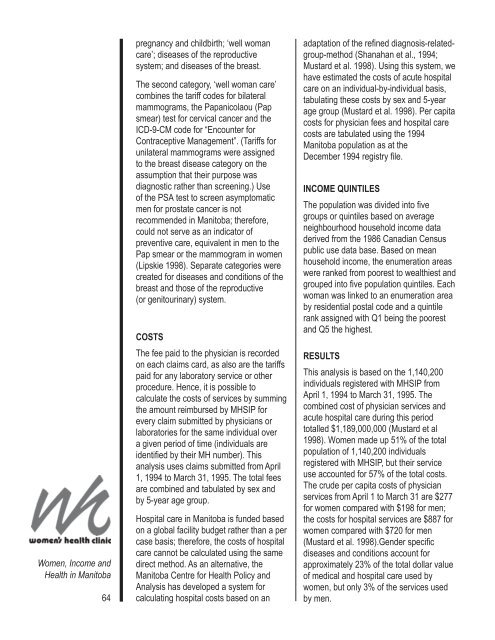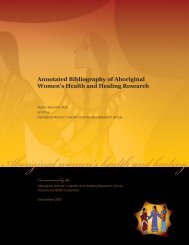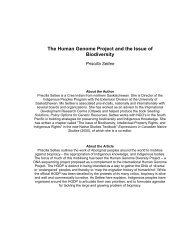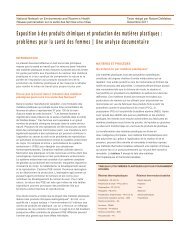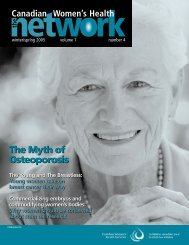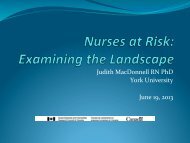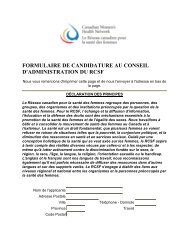here. - Canadian Women's Health Network
here. - Canadian Women's Health Network
here. - Canadian Women's Health Network
- No tags were found...
You also want an ePaper? Increase the reach of your titles
YUMPU automatically turns print PDFs into web optimized ePapers that Google loves.
Women, Income and<strong>Health</strong> in Manitoba64pregnancy and childbirth; ‘well womancare’; diseases of the reproductivesystem; and diseases of the breast.The second category, ‘well woman care’combines the tariff codes for bilateralmammograms, the Papanicolaou (Papsmear) test for cervical cancer and theICD-9-CM code for “Encounter forContraceptive Management”. (Tariffs forunilateral mammograms were assignedto the breast disease category on theassumption that their purpose wasdiagnostic rather than screening.) Useof the PSA test to screen asymptomaticmen for prostate cancer is notrecommended in Manitoba; t<strong>here</strong>fore,could not serve as an indicator ofpreventive care, equivalent in men to thePap smear or the mammogram in women(Lipskie 1998). Separate categories werecreated for diseases and conditions of thebreast and those of the reproductive(or genitourinary) system.COSTSThe fee paid to the physician is recordedon each claims card, as also are the tariffspaid for any laboratory service or otherprocedure. Hence, it is possible tocalculate the costs of services by summingthe amount reimbursed by MHSIP forevery claim submitted by physicians orlaboratories for the same individual overa given period of time (individuals areidentified by their MH number). Thisanalysis uses claims submitted from April1, 1994 to March 31, 1995. The total feesare combined and tabulated by sex andby 5-year age group.Hospital care in Manitoba is funded basedon a global facility budget rather than a percase basis; t<strong>here</strong>fore, the costs of hospitalcare cannot be calculated using the samedirect method. As an alternative, theManitoba Centre for <strong>Health</strong> Policy andAnalysis has developed a system forcalculating hospital costs based on anadaptation of the refined diagnosis-relatedgroup-method(Shanahan et al., 1994;Mustard et al. 1998). Using this system, wehave estimated the costs of acute hospitalcare on an individual-by-individual basis,tabulating these costs by sex and 5-yearage group (Mustard et al. 1998). Per capitacosts for physician fees and hospital carecosts are tabulated using the 1994Manitoba population as at theDecember 1994 registry file.INCOME QUINTILESThe population was divided into fivegroups or quintiles based on averageneighbourhood household income dataderived from the 1986 <strong>Canadian</strong> Censuspublic use data base. Based on meanhousehold income, the enumeration areaswere ranked from poorest to wealthiest andgrouped into five population quintiles. Eachwoman was linked to an enumeration areaby residential postal code and a quintilerank assigned with Q1 being the poorestand Q5 the highest.RESULTSThis analysis is based on the 1,140,200individuals registered with MHSIP fromApril 1, 1994 to March 31, 1995. Thecombined cost of physician services andacute hospital care during this periodtotalled $1,189,000,000 (Mustard et al1998). Women made up 51% of the totalpopulation of 1,140,200 individualsregistered with MHSIP, but their serviceuse accounted for 57% of the total costs.The crude per capita costs of physicianservices from April 1 to March 31 are $277for women compared with $198 for men;the costs for hospital services are $887 forwomen compared with $720 for men(Mustard et al. 1998).Gender specificdiseases and conditions account forapproximately 23% of the total dollar valueof medical and hospital care used bywomen, but only 3% of the services usedby men.


